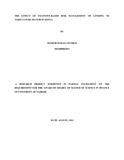| dc.description.abstract | A strong and efficient agricultural sector has a potential to enable a country feed its growing population, generate employment, earn foreign exchange and provide raw materials for country. it is however, that despite the great potentials that Kenya has in agricultural production, the country is a net importer of food. The major bane of Kenya’s agricultural development cited in the literature is low investment or credit. Financial services providers, including commercial banks in Kenya, generally view financing smallholder farmers as a high risk investment. Few banks accept farmers’ assets as collateral, and those that are willing to provide smallholder with loans charge very high interest rates, making it both difficult and appealing for farmers to invest in upgrading their operations. It is on the above reasons that this study investigated the effect of incentive-based risk management on lending to agriculture sector in Kenya. The lending to agriculture sector model was estimated using ordinal data. Both secondary data and primary data were used. Primary data was collected using closed ended questionnaire from a population of 43 commercial banks registered by central bank of Kenya. The collected data was analyzed by descriptive statistics. The data from questionnaire was coded and captured using Statistical Package for Social science (SPSS version 20.0). The findings revealed that incentive-based risk management expands lending to agriculture sector in Kenya. All the three independent variables-incentive-based risk management, banks’ market and bank’s size have positive impact on lending to agriculture sector in Kenya. The incentive-based risk management has the highest impact and influence on lending behavior of commercial banks and a change in it will yield the highest change in lending to agriculture sector in Kenya. The study therefore, recommends that banks and the government should strive to maintain incentive-based-risk management approaches efficiently so that their objectives of banks’ profitability and farmers’ benefits are achieved and multipliers effects maintained to the maximum. The study recommends further, that, the government should play a vital role by establishing a conducive environment characterized by favorable macroeconomic policies, adequate infrastructure, a strong human capital base, competent government administration, and political stability. This will mobilize effectively the creativity, drive, and resources of the private sector. | en_US |

